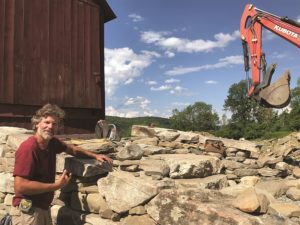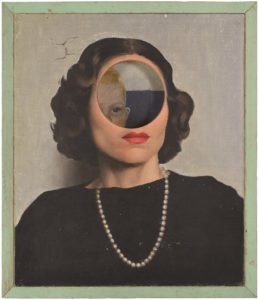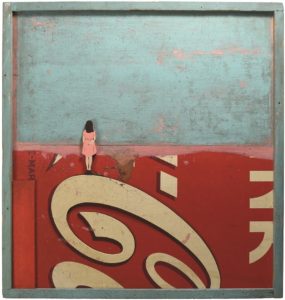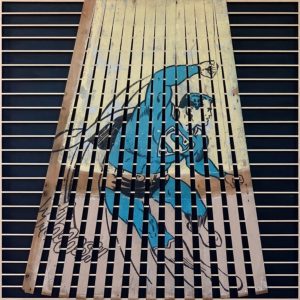“We’re here to communicate,” says Dave Laro. “We are all trying to make sense of this world we were born into.”
As an artist, Laro tells stories by collecting old wood and discarded objects and using them to create pop art constructions with subtle layers of meaning, leaving space for a deeply personal response.
“I feel that the artist and the viewer share in the creative experience,” Laro says. “It’s a collaboration. If somebody asks me what a piece is about, my response is, ‘Tell me what you think.’ ”

Laro has honed his skills since childhood. “Building out of wood is in me,” he says. “To me, it’s home.” His grandfather made furniture in a small workshop in Vermont, where Laro grew up. As boys, Laro and his brother first crafted wooden swords, then go-carts. After contemplating becoming a boatbuilder, Laro apprenticed under furniture maker and designer Charles Shackleton. “I didn’t stay there for long,” Laro says, “but the experience gave me an education in using tools and machinery.”
Laro began to design and create furniture on his own. “For a long time, I felt that what I was making had to be functional,” he says. “Art was not in my family or history, so it took me a long time to make something that would just go on somebody’s wall. I had to get comfortable with that, because it felt very personal.”
Looking back over the pieces Laro has been creating for nearly 20 years, a progression from implied, distorted functionality to increasingly pure and bold pop art expression is clear. From July 24 through Aug. 6, Laro’s most recent work will be part of a two-person show at the Kobalt Gallery in Provincetown, “D & D Construction,” along with fellow Vermont woodworking artist Duncan Johnson. Included in the exhibit is a collaborative piece, Over the Top, a first for both artists and an opportunity, Laro says, that he found “very exciting, because I was asked to let go — something I am working on.”

Laro’s process is usually solitary and contemplative. He spends a great deal of time wandering through flea markets, searching for everyday objects and old discarded pieces of wood. These unlikely treasures, unique in the ways in which they have been used, loved, worn out, transformed, and broken over the years, fill Laro’s workshop and home, waiting to reveal “their own mystery,” he says. Only when he has figured out which objects and pieces of wood fit together, thereby suggesting “an opportunity for a story to be told,” does he begin to construct one of his artworks.
“Usually it starts with color,” Laro says. “There is a visceral response in us to certain colors.”
Take, for example, the genesis of Little Liar, one of the works in the Kobalt show: “I started with an old toolbox,” Laro says. “It was originally pink, then somebody had painted it blue, but the pink was showing through in areas where it was worn. Then, I found part of an old Coca-Cola sign with pink paint on it that matched perfectly. So, I put the two next to each other and thought, how can I add something to this to make it relevant? I walked through my house looking for colors that worked. There was the little girl with that same pink, and the white of her skin matched the Coca-Cola. I started playing around, thought of facing her forward, but facing her backward was more intriguing.”
A piece like Little Liar evokes obvious, societal questions as well as hidden memories and histories. “I try to give the viewer agency to interpret,” Laro says. “The first person who saw this piece was a dear friend of mine. A member of her family had drowned, and what she saw was her relationship to the fear of water. She saw the little girl as herself.”

Laro carefully considers each piece’s impact. “There are times,” he says, “when I have laid something out and I just can’t do it. Everything works, but it’s just too sensitive to me right now. Our society is pretty polarized, and a lot of what is happening in our world is not good or healthy. So, I have to ask myself, ‘Is this going to help?’ And even though the piece works as art, sometimes the answer, to me, is no.”
He asked himself the same question after creating On Second Thought, a piece in the Kobalt show that uses part of a painting that had already found its way into a much earlier work. “The woman [in it] is very mysterious,” Laro says. “I knew that I wanted to do something compelling with what was left of her. After six years, I found this other oil painting with the same hue and put them together. I saw that there were many implications. It’s heavy stuff, you know? And it was one of those pieces where I asked, ‘Do I make it?’ ”
To Laro, in the end, creating art is a celebration of this life in all its complexity. “Every time I build something, I hope to learn something new,” he says. “I’m learning about myself, and I’m growing. That’s what this whole thing is about to me.”

Wood to Go
The event: “D & D Construction,” an exhibit of artwork by Dave Laro and Duncan Johnson
The time: Friday, July 24, through Aug. 6; gallery hours: Sunday-Tuesday, noon to 5 p.m.; Thursday-Saturday, noon to 8 p.m.
The place: Kobalt Gallery, 366 Commercial St., Provincetown
The cost: Free



